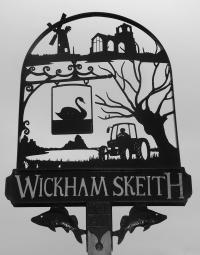

|
Village Maps – Part 2
The Ordnance Survey has been producing maps of the UK for 230 years. As the name implies its origins were military, deriving from the need for the mapping of Scotland in the wake of the Jacobite Rebellion of 1745 & of England during the Napoleonic Wars. Initially the whole country was mapped at a scale of 1 inch to the mile but it is the larger scale maps of 6 inch & 25 inch to the mile later in the 19th century which interest us here. It can be argued that these are the greatest maps ever made.
The best free source for viewing these maps is the National Library of Scotland – although it doesn’t have copies of every edition. They can be accessed here: An alternative site is: https://www.old-maps.co.uk/#/ although you can’t zoom in as much as you can with the NLS versions.
On the facing page is the area covering the Green on the 1st edition 25 inch map for Wickham Skeith surveyed in 1885. The NLS copy is coloured (blue for water & red for buildings) but is reproduced here in greyscale. If we put it alongside last month’s map, many differences are apparent:
1. The Green is now the same size as it is today with the northern edge following the road.
2. The school (built around 1845) is now present. There is no Village Hall yet as that wasn’t built until 1909.
3. The Grimmer & all buildings are now accurately drawn to scale compared with the rough outlines in the Tithe Map.
4. An extraordinary feature is the depiction of each individual tree in fields & hedgerows. This only appears in the 1st edition; when the map was revised in 1903 these trees were removed. It was just too much work to remove those which had been cut down & add new ones that had grown in the meantime.
5. On the north side of the little green next to the school, there is a pound marked. This is where any animals not permitted to graze were kept to be claimed by its owner who was presumably fined. (Does anyone have any information about grazing rights on the Green?)
6. The Entry has been developed since 1840. There are a number of new cottages & the Wesleyan Methodist Chapel (now the Old Chapel), which was built in 1861, is there.
7. There is a clear track across the Green between the Grimmer & the Post Office. This was made up with cinders & was called the black road. Nigel tells me that in a dry year the line of this track can be seen.
Pete Davidson pjdavidson42@gmail.com
|

|
Water, water everywhere …… We take so much for granted these days; turning on the tap for safe, drinkable water is one amenity we couldn’t imagine being without. Mains water didn’t come to the village until the 1950s and even then it wasn’t supplied to all houses, only to outside standpipes for some. Some houses had their own wells and hand pumps and a few of these are still there. However, most residents had to use one of 3 public pumps. There was one on the Street. (Where was it – can anyone tell me please?) Another was on the Green between the Grimmer and the old Post Office where the two Chestnut trees are. The third one, and the only one we have photos of, was at the end of Church Lane outside 8 Kitchen Close. The postcard, from the late Alan Lummis, dates from 1925/6, soon after Kitchen Close was built. The pump can just be seen on the right hand side. The close up of the pump is from Marion Bland and shows Cissie with the 2 buckets she was about to fill with water. Collecting water was a daily task and the pump was a place where people would meet for a chat in an era when the pace of life was perhaps a bit slower. According to Parish Council minutes, the pump here was closed in 1957 and tenants had to use an outside standpipe. The pump on the Green was removed in 1959. As to mains sewerage, that didn’t come until 1968. Pete Davidson |





